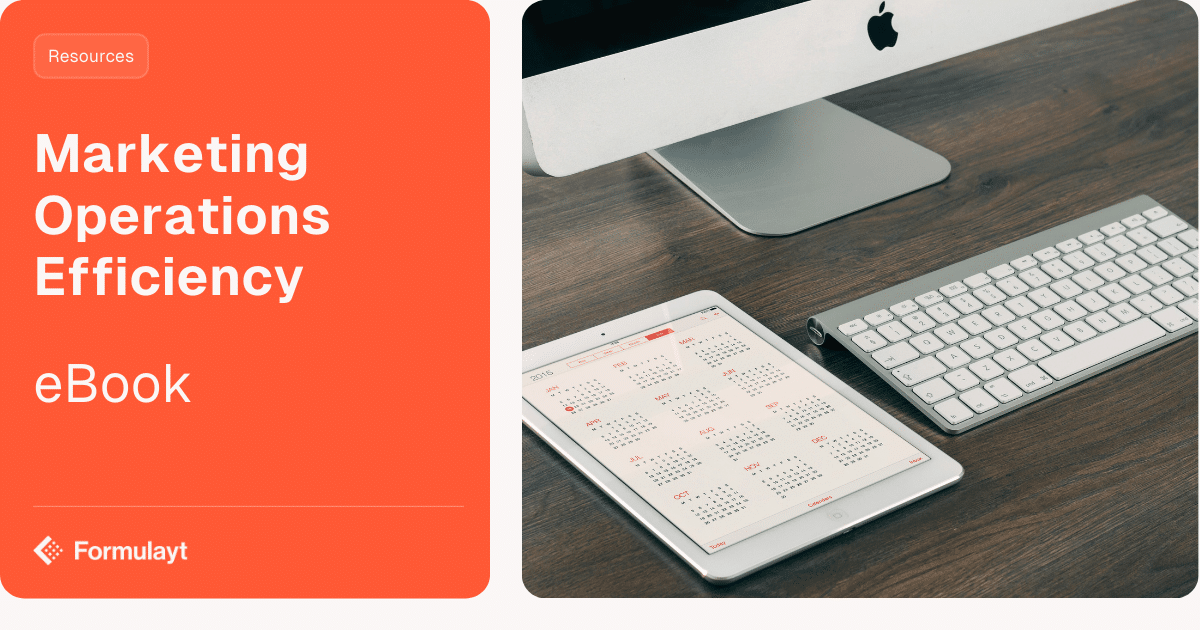Improving Marketing Operations Efficiency with Smart Data Capture

What is Marketing Ops Efficiency?
Marketing operations should enable marketing teams to adapt quickly to changes in the market; business strategy and customer behaviour.
The increasing influence of digital technology in marketing has expanded the scope of marketing ops beyond project management, rather acting as the foundation supporting the whole marketing function.
Marketing ops are now responsible for the evolution and improvement of marketing performance reporting; marketing systems and technology; data; and process development, to name but a few. Marketing ops has also facilitated and improved the relationship between the marketing department and IT, operations and sales, leveraging these relationships to drive operational efficiency and marketing effectiveness.
The critical principles of marketing operations efficiency are:
- Automation, standardization and process improvement
- Data & testing
- Use of technology for competitive advantage
- Governance and risk management
Marketing ops focuses on the efficiency of the whole marketing engine, but here we’re going to focus on just one subject, lead capture standardization and process improvement.
Lead capture is an area critical to driving marketing and sales results and wider business growth. There’s almost always room for improvement when it comes to lead capture. We’re going to deep dive into how lead capture standardization and the management of lead capture processes can help decrease the risk of inefficiency, that can result in serious potential cost to the business.
Why is Unstandardized Lead Capture an Area of Risk?
When it comes to lead capture there are a series of risks that are the responsibility of a marketing ops professional to mitigate. These risks become complex and the potential fallout increasingly detrimental as you scale marketing operations, so it’s critical to tackle these risks from the outset.
Data Governance
This means that it is an imperative to deploy a data governance framework that fits your organization and your future business objectives and business models. In this case, standardized lead capture needs to make up part of that strategy. Without it, data capture will be inconsistent and unreliable. This not only negates the value of the investment into marketing infrastructure and data capture activity, but it makes using that data for business critical decision making almost impossible.
Data Privacy and Brand Perception
Marketing Agility
In the competitive globalized market we operate in, marketing agility is absolutely critical to gain and maintain competitive advantage.
Where lead capture processes aren’t standardized, technical resources are often required to build and configure lead capture in a bespoke fashion. Waiting for IT or technical teams to deliver this work can seriously slow down a campaign launch. Add to this, testing and quality assurance time required to test the data flow for each lead capture process, this is a cumbersome and time consuming task. Agile marketing relies on the ability to plan, deploy and even A/B test lead generation strategies quickly. A non-standardized, bespoke lead capture process does not support this approach.
Risk of Lost Revenue
The time it takes to deploy non-standardized lead capture processes can result in lost revenue through the risk of either losing leads because of a cumbersome process or driving poor quality leads due to an ineffective and untested lead capture strategy. If lead capture is non-standardized, it’s difficult to extract any consistent trends from the data because it’s not comparable. It is also difficult to A/B test and act on results.
The other factor affecting revenue is a need to understand how to extract value from all of the information collected and stored, in order to improve business performance. For this to work effectively your lead capture process needs to mirror your business objectives consistently, across all regions. This can’t happen with a non-standardized approach.
How can you Mitigate the Risks?
It’s not all doom and gloom! Standardizing lead capture can mitigate against the risks described above, making the job of the marketing ops team, and the wider marketing team far easier and more fruitful.
Centralized Data Governance
- Data architecture
- Data modelling and design
- Data storage and operations
- Data security
- Data integration and interoperability
- Documents and content
- Reference and master data
- Data warehousing and business intelligence
- Metadata
- Data quality
Standardized Form Processing in a Single Flow
Non-standardized lead capture complicates lead form processing by having one form for a single purpose, then building individual data flows off each form.
For example, once a prospect fills in a form, they’ll then be added to a list in the CRM and enrolled in a workflow - these actions are likely to differ for every single form. This could mean if you have 1000 forms, you’ll have 1000 processing flows. Having multiple forms with multiple lead flows requires more time, more testing and more ongoing maintenance.
The solution here is to create a standardized lead process flow in the backend that reacts to metadata coming in from your web forms. We’re talking about setting up a standardized process flow that applies to all of your lead capture forms, where the lead flow is predefined within a set of parameters appropriate to the business and marketing strategy you’re operating under. The main advantage is a centralized point of process for lead capture less risk, easier maintenance and a reduced requirement for testing.
Build Global Standards into your Strategy
Usually you’d endeavour to achieve this through form pre-population based on user location, but to mitigate risk from VPNs and unreliable IP data, you’d provide the option for the user to manually select their country from a drop down which would auto-update the form fields according to that countries pre-set rules.
Individual Market Requirements
Differences between global market position or requirements is something else to consider. An example of this might be if someone in the US and someone in the UK fill out the same form on your site. If you knew that your market share and brand in the US was well established, you might feel more confident in increasing the number of fields to capture more data, without it affecting conversion rate. But, in the UK you know your brand awareness and market share is much weaker, you may decide you’d prefer to reduce barriers to conversion by asking for less information.
Template Lead Capture Forms
Using a centralized template for lead capture forms can significantly decrease risk around time consuming processes; reduced agility and difficulty collecting measurable and comparable data.
By centralizing the form template, the data captured is consistent and changes can be made quickly.
For example, you may have multiple download forms set up by regional marketing teams globally, with different privacy settings and lead information gathered. This makes it difficult to control a) whether you’re compliant with local data regulations and b) consistency in data capture. With a templated master form, you’re capturing the same type of data and privacy settings which automatically update to the company standard according to IP address. Furthermore, any changes that need to be made to the form can be made just once, and they’ll automatically deploy to all forms based on that master.
Empower Marketers to Improve Efficiency
Empowering marketers to improve efficiency is the best way to solve the problem of reduced agility caused long lead times of technical changes.
Providing tools or workflows to deploy lead forms that don’t require technical skill to implement, puts the power back into the marketers hands to quickly test and deploy any number of lead capture forms at the click of button.
The other critical thing to consider when standardizing form templates as above, is ensuring you support all use-cases in the standardization. For example, there may be cases where a marketing manager needs to test something really specific that doesn’t adhere to the master template. In this case you’ll need to build a use-case option to allow data capture for this particular scenario.
How are Costs Reduced by Standardized Lead Capture?
What are the Secondary Benefits?
Improved Measurement
Reduced Risk Against Privacy Non-compliance
Better User Experience
Marketers Spend More Time Thinking About Marketing
Rather than chasing up minor technical amends and holding campaigns back whilst waiting for changes, marketers are able to spend the time deploying and reviewing activity.
Technical Teams Removed from the Burden of Building or Testing Lead Capture
Building and testing lead capture can be time consuming and not all that interesting. This allows technical teams to refocus their energy into more valuable projects.
How much you could improve
your web conversion by?
By analyzing your current web conversion rates and optimization practices, we can estimate the projected uplift in leads you can expect from working with Formulayt.
You may be interest in these article next
Double the ROI on Your Marketing Tech Stack
Too often, marketers focus on the deployment of a shiny new tool rather than focusing on maximizing the return on the tools they already For example, a company interested in increasing leads from their website might dedicate a sizeable portion of their marketing budget towards driving traffic from advertising. However, all the traffic in the…
How Form Inconsistencies Contribute to Data Hygiene Problems
Businesses have learned the importance of collecting data, but many are still unaware of how difficult it is to use if not governed properly. Here’s how to maintain data integrity.
How to Scale a Global Marketing Team
To organizing marketing data, the capturing of leads and collection of lead data needs to be carried out efficiently. However, creating web forms and landing pages can be challenging when you factor in the ever-growing needs of local marketing teams.



